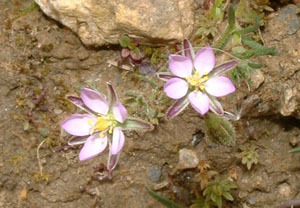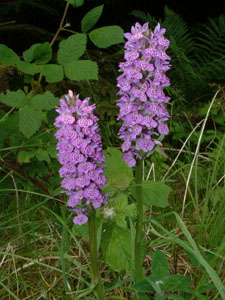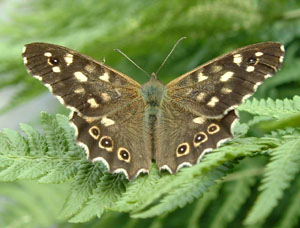June 2003 - Part 3
21st June
The longest day, and the largest list of plants:
First, the Hedge Woundwort:-
This Field mouse-ear has been flowering for some time....
The
Goosegrass has featured in many previous images, but now it's in flower, too.
The Greater Plantain has been in leaf for months, but has just thrown up these spikes. It's closely related to the Ribwort.
The Self heal is yet another medicinal plant on the patch.
I have to admit, I was wondering when this Pale Persicaria would make an appearance. I have seen it in almost every place I've lived.
And lastly, for today, a tiny sedge. I'm unsure exactly which one it is. The whole plant is only 3" across.
22nd June
The Bush Vetch has been flowering everywhere since April. I
thought this was yet another one, until I saw the blue flowers. That makes it
the Tufted Vetch.
The
Nipplewort has been in bud for quite a few weeks. It opened everywhere this
morning.
The Procumbent Pearlwort has flowers that are only a couple of millimetres across:
This
Slender St. John's Wort is closely related to the Tutsan. I'll also have
flowering pictures of the Square-stemmed St. John's wort, soon.
24th June
Two plants new to me, today: 1) Thyme-leaved Speedwell. The
spike is 2" high, and the flowers are 2-3 mm across.
2) Sand Spurrey - a rare and beautiful flower that is less than 1cm. in diameter

A couple of more shots of the Spotted Orchids, to show the wide colour variations and lip shapes.
The Birds-foot Trefoil has been growing for weeks, and I
spotted this developed flower-head behind some grasses.
This
Creeping
Thistle caught my eye. The plant was growing on a bank, and the flower was at
eye-level for me.
Ragwort is deadly to horses, and is regularly destroyed for that reason.
Isn't it good to know that Blackfly don't just invade your
garden?
(The Hardhead will return when properly in flower)
This little (1
cm) Sawfly was very active and was notable by its large black eyes.
And the Rose of Sharon flower is quite spectacular:
25th June
Another pale Spotted Orchid:
The
Meadowsweet has flowered, now
This Geometer moth looked good, so......click!
It looks like the Silver-ground Carpet moth.
26th June
The red ants were very busy, today. I had to use flash to freeze them
This partial view of the Ringlet was the only one I could get:
:
Eyebright was thought to have properties that helped the eyesight. The flower is only a few mm across.
The spotted orchids are becoming more prominent, now.
And
here's a close-up, showing the pollinia still in place

And finally, the other end of the spectrum: The Northern Marsh Orchid. This hybridises with the Common Spotted Orchid, so I'll look out for that.
27th June
12 hours of torrential rain followed a hot dry spell. I managed to find a gap between showers. Many of the photos show lying water - quite attractive.
I was
checking the Lesser Burdock for flowers and spotted the mosquito lurking.
The Meadow Vetchling is yet another pea, as you can see from its seed pods.
And now a series of Hypericum species. They all flowered for the first time on the same day - amazing. Compare these with the Rose of Sharon from 24th June.
Hypericum species are generally known for their healing properties.
Two St John's Worts. Slender on the left and Square stemmed on the right:
And the Tutsan:
The Dog
Rose shows a nice amount of water from the rain.
And lastly for today, a Collared Dove. I saw a cock Reed
Bunting, earlier, but a passing pedestrian scared it off.
28th June
Bright sunshine again. today...this bumble bee was clearly 'over-indulged'...it couldn't move.
This is another Ichneumon wasp....
And yet another Hoverfly...the Striped Hoverfly. The Buttercup flower gives some idea of scale.
And this is (we think) the American Willowherb:
29th June
Here's a (ragged) Red Admiral. Maybe I'll get a better one
later.
And this
is a Dronefly, busily feeding on a Dandelion
And now the seed pods of a Foxglove, and we're still in June.
It seems
like I've been waiting for the Spear Thistle to flower for months, rather than
weeks.
I used to eat the 'choke' from these when I was a kid - painful, but tasty. (They're related to the Artichoke)
I've seen quite a few Honey Bees, but they're generally too busy to stop for a photo opportunity.
This Speckled Wood allowed me to get in quite close with the macro lens...about 3cm....

30th June
A Crane fly, otherwise known as Daddy Long Legs:
Yet another pale
Common Spotted Orchid. Note how the pale purple pattern looks exactly like an
insect's wings - to act as a lure.
It's worth seeing the Tutsan from the side, too.
This is Rape
So that's the first half of the year over. I've counted roughly 120 different plant species so far - way above my original annual estimate. Now that June's over, things should start to slow down a bit, but it's still a large number of species for such a small geographic area.
Back to Home page Back to June - Part 1 Back to June - Part 2 Feedback Annexe News